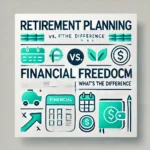Retirement Planning Vs. Financial Freedom: What’s The Difference?

When it comes to securing your financial future, the terms retirement planning and financial freedom are often used interchangeably. While they share some similarities, they represent distinct goals with unique approaches and outcomes. Understanding the difference between the two can help you navigate your financial journey more effectively.
What Is Retirement Planning?
Retirement planning traditionally focuses on saving enough money to support yourself once you stop working. It involves creating a nest egg that can cover living expenses, healthcare, and lifestyle needs during your retirement years. The primary goal is to ensure financial security when your primary source of income (your job) is no longer available.
A typical retirement plan might include:
- 401(k) or IRA accounts: Tax-advantaged savings accounts that grow over time.
- Pensions or Social Security: For some, these form the backbone of retirement income.
- Budgeting for fixed expenses: Allocating funds for housing, healthcare, and daily living costs.
While retirement planning is crucial, it often focuses on creating a future that meets your basic needs. It assumes that you’ll live on a fixed income, which can limit flexibility, especially as unexpected expenses arise.
What Is Financial Freedom?
Financial freedom, on the other hand, is a broader concept. It’s about having enough wealth to cover your expenses indefinitely without relying on a 9-to-5 job or living paycheck to paycheck. Achieving financial freedom means you control your money, rather than your money controlling you. It offers flexibility, independence, and the ability to pursue passions, travel, or spend time with family without financial stress.
Key components of financial freedom include:
- Eliminating debt: Paying off liabilities like credit card balances, mortgages, and student loans.
- Building multiple income streams: Investing in assets like real estate, stocks, or business ventures that generate passive income.
- Smart money management: Using tools like budgeting and financial technologies to maximize savings and reduce unnecessary expenses.
Unlike retirement planning, financial freedom isn’t tied to a specific age or stage of life. It’s about reaching a point where you have the financial flexibility to make choices based on your values, not your bank balance.
The Middle-Class Trap: A Real-Life Example
The distinction between retirement planning and financial freedom becomes clearer when we examine how financial habits are shaped by societal norms. For instance, many middle-class individuals work tirelessly to “live the dream” by buying homes, cars, and other assets financed through debt. The blog author’s personal story illustrates how the pursuit of this dream can lead to financial stress, especially when unexpected life events like divorce or market crashes occur.
After experiencing significant debt following the 2008 housing crisis, the author discovered a technology that helped them eliminate $1.2 million in debt in just seven years. This transformative experience shifted their mindset from being a consumer to thinking like a bank. Instead of focusing solely on retirement savings, they explored innovative strategies like using life insurance policies as financial tools.
How Life Insurance Fits into Financial Freedom
Most people think of life insurance as a way to protect their family in the event of their death. However, banks and wealthy individuals use it as a powerful financial instrument. Concepts like BOLI (Bank-Owned Life Insurance) and POLI (Private-Owned Life Insurance) show how life insurance can generate wealth, reduce debt, and create passive income streams.
Here’s how it works: By overfunding a life insurance policy, you can use the policy’s cash value as collateral to pay off debt, generate interest, and still leave a legacy for your heirs. This hybrid financial arbitrage system allows individuals to “be their own bank,” turning liabilities into assets and achieving financial freedom much faster than traditional methods.
Retirement Planning vs. Financial Freedom: Which Should You Aim For?
While retirement planning is about preparing for life after work, financial freedom is about creating a life where work is optional. One isn’t necessarily better than the other—it depends on your goals and values.
If your priority is ensuring a comfortable and secure future, traditional retirement planning is essential. However, if you want to break free from the paycheck-to-paycheck cycle and live life on your terms, financial freedom should be your ultimate goal.
The good news? These two approaches aren’t mutually exclusive. For instance, the cash value from a well-designed life insurance policy can supplement your retirement income while also allowing you to live debt-free. Tools like POLI combine the best aspects of retirement planning with financial freedom, offering a more holistic approach to wealth building.
Final Thoughts
Understanding the difference between retirement planning and financial freedom can empower you to take control of your finances. While both are valuable, financial freedom offers a more flexible and empowering vision of what life can look like—one where you’re not tied to a rigid plan but can adapt and thrive regardless of life’s uncertainties.
If you’re ready to take your finances to the next level, start by learning more about strategies like life insurance arbitrage, debt elimination, and passive income generation. With the right knowledge and tools, you can go beyond retirement planning and achieve true financial freedom. After all, isn’t the goal of wealth to live life on your own terms?
